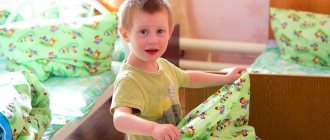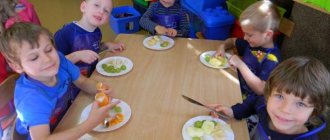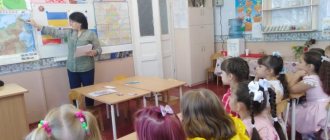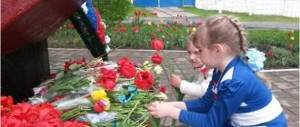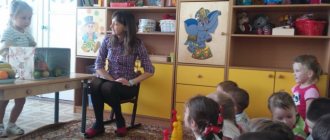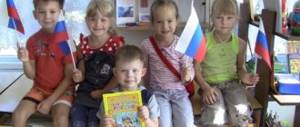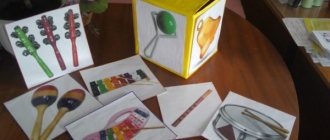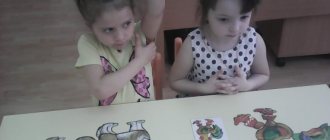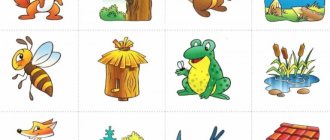Patriotic education needs to start as early as possible - even in kindergarten it would be appropriate to teach children to love the Motherland and their native land. But pretentious speeches about the Fatherland are not suitable for this. Patriotic corners are also difficult for most preschool children to perceive. Games for preschoolers for patriotic education are much better suited. They are simple, understandable, and help in a playful way to realize all the greatness of Russia.
For teachers of older groups, we still recommend that you familiarize yourself with the design of patriotic corners in preschool educational institutions. We have collected photos of interesting ideas, and the content diagram will help you complete the corner with your own hands.
Patriotic education through play is the easiest way to influence the consciousness of children. Most of the games are simple, suitable for any kindergarten; no special requirements or equipment are required. The most important thing is to structure the gameplay correctly so that students are interested in learning new things and begin to imbue themselves with patriotic sentiments without noticing.
Let's consider games that will help cultivate patriotism in the younger group of kindergarten. Children at this age perceive very well everything related to family, nature, and friends. There is no need to make patriotism the goal of every game; the theme of love for the Motherland should be connected with the education of humanity. After all, the goal of education is, first of all, a Man with a capital “H” who loves his Fatherland.
Game "Magic words"
The most important thing in this game is to learn phrases that show a person’s general culture. For example, “thank you”, “please”, “bon appetit”, etc. The gameplay is structured as follows: you first need to tell the children about the importance of “magic words”, and try as a whole group to remember as many of these words as possible. Along the way, they talk about the meaning of these words and the appropriateness of their use. After this, the participants name all these words in turn. The winner is the one who can remember the words more than others. The game develops memory and thinking, helps all participants become more polite and cultured.
Organization of patriotic education in libraries
“Game as a means of patriotic education of preschool children” consultation for educators
Cultivating a sense of patriotism in dramatization games on a folklore and environmental basis occurs, as it were, indirectly. It does not directly say that the Motherland needs to be loved, protected, protected.
Role -playing game
is used as one of the active forms of work on the patriotic education of children. It is often underestimated by teachers and parents. The themes of the games are monotonous, the plots are poor and formal, the roles are traditional. Games with a military-patriotic theme, reflecting the heroic deeds of our people, are becoming quite rare. Children mainly reflect the plots of foreign cartoons and films and develop aggressive plots. Here is a diagram of consistent work on patriotic education of children through role-playing games.
FAMILY KINDERGARTEN NATIVE STREET, DISTRICT HOMETOWN COUNTRY, ITS CAPITAL, SYMBOLICS
RIGHTS AND DUTIES (CONSTITUTION) .
Recently, the family has been going through hard times: in an effort to earn their daily bread, parents are paying less and less attention to their children, and the number of dysfunctional, single-parent families is growing. It is becoming increasingly difficult for a child to love his home, family, or kindergarten. Therefore, it is necessary to create conditions for the formation of an emotionally rich image of home in children. Children must learn not only to take, but also to give: to take care of loved ones from childhood, to be attentive to each other, to help in word and deed. We can implement these tasks through the role-playing game “Family”. There are several variations of this game. For example, “Family holidays”, “Family visiting grandma”, “Our friendly family”.
It is difficult for children of primary preschool age to imagine the city as a whole, which means we introduce children to what surrounds them, namely the kindergarten and the premises located in it. We conduct acquaintance in the form of excursions. We talk about the work of people working in kindergarten. We read the relevant literature and look at thematic illustrations. Children use and consolidate the acquired new knowledge in role-playing games: “Kindergarten”, “We sing a song”, “Who looks after us in kindergarten”, “We are cooks”. Older children play games such as “Fashion House”, “Cafe”, “McDonald’s”.
The task of educators is to create an emotionally prosperous atmosphere in kindergarten, where relationships between adults and children are built on goodwill, mutual respect, where the child will feel welcome and protected. Then children will experience love and affection for their home, kindergarten, and go to kindergarten with pleasure.
The attention of older children needs to be drawn to objects located on the nearest streets: school, cinema, post office, pharmacy, etc. It is necessary to talk about their purpose and emphasize that all this was created for the convenience of people. The acquired knowledge is used in games such as “School”, “Mail”, “Pharmacy”, “Atelier”. The following games allow you to get to know your native places in more detail: “This is my street”, “Travel by bus”, “I am a hairdresser”, “Our hospital”, “Gegetable shop”.
Game "Find the flag"
Before the game, you need to ask the students who knows what the Russian flag looks like. After this, the flag of our country is demonstrated and its colors are called. They show flags of other countries and briefly talk about their colors and general design. After this, 10 flags are placed, among which is the Russian flag. The child is asked to find the Russian flag and name its colors. If the student makes a mistake in his choice, then he needs to sort out the mistakes in order to play the game again.
Children should be raised to respect the state symbols of not only Russia, but also other countries. Under no circumstances should children be allowed to trample on flags or handle them carelessly.
Game "City Guests"
The goal is to instill in children an interest in the life of their hometown and the country as a whole. You need to pin six photographs with iconic places of your city on the board, pre-numbered with numbers from 1 to 6. The child is asked to roll a dice with numbers to randomly select one of the pictures. The selected picture must be described in such a way that a visitor to the city understands the image and has a desire to visit this place. Cards with views of the city should be selected as recognizable as possible, so that children do not have problems with the description.
Moral and patriotic education of preschool children through play
The harmonious development of a child is the basis for the formation of a future personality.
It depends on the successful solution of many problems, among which issues of moral and patriotic education occupy a special place.
Play is a natural companion in a child’s life, a source of joyful emotions and has great educational power.
In the game, the child actively rethinks the accumulated moral experience; everyone has to voluntarily give up their desires, coordinate their thoughts, agree on joint actions, obey the rules of the game, restrain their emotions, and overcome difficulties.
The game teaches you to fairly evaluate your own results and the results of your comrades.
Moral education implies the cultivation of friendly relations between children, the ability to negotiate, work, play, and please elders with their actions.
This also includes fostering a respectful attitude towards others.
When introducing children to the city, you need to pay attention to the sights, visit museums, and see historical places. The idea that everyone is interested in their hometown encourages pride in their homeland. An important means of patriotic education is to introduce children to folk traditions.
Folk games, proverbs, sayings, and fairy tales form love for one’s people, for one’s country. Folk games are an integral part of the moral and patriotic education of preschool children. In terms of content, folk games are laconic, expressive and accessible to children. They reflect the way of life of people, their work, way of life, the idea of \u200b\u200bcourage, courage.
The peculiarity of folk games is that they teach the child to find harmony with the world around him. Also, many verbal games are used in the education of moral feelings.
For example, the games “River of Politeness” (children line up in pairs one after another, the child without a pair stands in front, he, pronouncing the magic word, chooses a mate), “Tasty Words” (a child with his eyes closed determines who said the polite word).
Didactic games occupy a special place in the formation of moral and patriotic qualities of a preschooler. They develop intelligence, the ability to coordinate their actions with other participants in the game, and independently solve the task.
In play, children are attracted primarily to heroic roles, as well as roles of great social significance.
In preschool age, children develop character traits and moral qualities. The process of development of the child’s psyche is underway. The moral development of a child goes through a complex path; it depends on many factors. Play for a child is the main activity.
Play for preschool children cannot be replaced by other activities. For a child, play becomes the meaning of his existence: he communicates, develops physically, strengthens morally, and learns about the world around him. If a child does not play, then he does not receive full knowledge about life, culture, love for loved ones, care, the social sphere, and nature.
Games that they create themselves are of great importance for children. In them they create what surrounds them. Children in games use the role of actors, directors, and decorators. They prepare thoroughly for their roles, but play spontaneously, for themselves, welcoming improvisation. In games, children demonstrate both independence and collective creativity. This is manifested in the fact that children have common interests and goals in play, and they work towards it with great effort. The quality formed in the game influences the child’s behavior. The knowledge that a child receives with the help of adults at home, on walks, in kindergarten is a good means of moral, patriotic and mental education.
Let's take a closer look at what place play occupies in a child's life, especially in preschool age. For him, playing is the most serious matter. In the game, the world opens up to children, creative personalities are revealed. The game is a huge bright window through which a life-giving stream of ideas and concepts about the world around us flows into the child’s spiritual world. A game is a spark that ignites the flame of inquisitiveness and curiosity.
Literature:
1. Program of education and training in kindergarten”, ed. M.A. Vasilyeva, V.V. Gerbova, T.S. Komarova.
2. Moral education in kindergarten, ed. Nechaeva, 2014
3. Pecherova A.V. Educational games for preschoolers. - M.: VAKO, 2008- 192 pp. - (Preschoolers: we teach, develop, educate).
4. Bodrachenko I.V. Gaming leisure activities for children. M.: Sphere shopping center, 2011.
"Heraldry"
The goal is to study the history of the native city through its symbolism. First, the teacher shows the coat of arms of his hometown and briefly talks about what is depicted on it. The story needs to be told in simple and understandable language; usually the image of the city’s coat of arms carries a graphic image of its specifics and historical features.
After this, the coats of arms of the district and region are shown, and they are also told about them. At the very end they move on to the coat of arms of Russia. It is also necessary to talk about the flag of the city, region and country. Children are shown the relationship between the flags of the city, region and country, and superimpose them on each other. Then the pictures are mixed and asked to put together the coat of arms and flag of the city, region, or country. That is, split them into pairs. This game not only develops memory, it will help you learn about the symbolism of your native land.
Modern problems of patriotic education
Card index of didactic games for patriotic education of preschool children
Slide 1
Card index of didactic games for moral and patriotic education A didactic game allows children to become more involved in current life in forms of moral experience accessible to them. A didactic game for moral and patriotic education allows you to discover a complex of various activities of children: thoughts, feelings, experiences, empathy, searches for active ways to solve a game problem, their subordination to the conditions and circumstances of the game, children’s relationships in the game. The proposed games and exercises can be carried out by a teacher, educational psychologist during a walk during the morning reception, in the evening hours, during the period of free activity of children “My address...” Purpose: to develop the ability and knowledge of children to name their home address, street (complex) of the city of Nizhny Novgorod, house number, apartment number, telephone number, floor, consolidate knowledge of the right to housing, inviolability of the home. Material: ball Progress of the game: everyone stands in a circle, the teacher passes the ball to the child and says: “I live on ... floor,” the child continues, naming his floor, and passes the ball to his neighbor, etc. “Our kindergarten.” Goal: to consolidate children's knowledge about children. kindergarten, about kindergarten workers.. What duties do they perform. Where is the band, music room, etc. located? Strengthen the ability to navigate according to a plan in space Material: photographs and illustrations of the kindergarten, kindergarten workers. Plans for the kindergarten, 1st, 2nd floors, groups Progress of the game: From photographs and illustrations, children learn and talk about the workers of the kindergarten. According to the plan, children navigate the space “A child learns what he sees in his home...”
Slide 2
"Our country". Goal: To reveal children’s knowledge about our Motherland, its capital Material: illustrations of the city of Moscow, world map, photographs. Progress of the game: the teacher shows illustrations and pictures, asks questions. Children answer “Small Motherland”. Goal: To reveal children’s knowledge about their Small Motherland, about the history of our city, monuments and sights of Nizhny Novgorod Material: illustrations, photographs of the city Progress of the game: the teacher shows illustrations and paintings. Question answer,. "Search for kind words." Goal: to reveal with examples the meaning of the words “sorry, excuse me”, to cultivate friendly relations, to explain the need for an apology, an admission of guilt or proof of rightness and justice., the connection between words and deeds, words and attitudes Progress of the game The teacher begins a story about how to apologize. where and when, how these polite words “A journey along the route of good feelings, actions, deeds and relationships” are applied.” Goal: to draw children's attention to the fact that good feelings, actions and deeds evoke a feeling of respect, friendship and love. Form friendly relationships, establish rules of etiquette, rules of behavior. Material: pictures with different scenes of good deeds, good and bad behavior Progress of the game The teacher begins a story about how to behave in a particular place, what good deeds...
Slide 3
“Flag of Russia” Goal: to help consolidate knowledge of the flag of your country, (city, Republic) to consolidate the main colors of the flags, what do they mean? Material: stripes of red, blue and white Progress of the game: The teacher shows the children the flag of Russia, removes it and offers to lay out the multi-colored stripes in the order in which they are on the flag of Russia “Coat of Arms of Russia” Purpose: to help consolidate knowledge of the coat of arms of their country (city , Republic) to consolidate knowledge about what is drawn on the coat of arms and what it means Material: a picture of the coat of arms cut into 6-8 parts Progress of the game: The teacher shows the children the coat of arms of Russia, and invites the children to compose the coat of arms as one whole from the parts of the picture. “Tell about your family” Goal: To form an idea of yourself as a family member. Show the importance of family in a person’s life. Develop a desire to talk about your family members, be proud of them, love them. Material: Photo album, compiled together with parents with family photographs with a family tree “Find the flag of Russia, the city of Nizhny Novgorod Purpose: to help consolidate knowledge of the flag of your country (city, consolidate the main colors of the flags, what do they mean? Material; pictures depicting different flags Game progress: among the 4-6 proposed flags, find the one you need
Slide 4
“Find the coat of arms of Russia, the city of Nizhny Novgorod” Goal: to help consolidate knowledge of the coat of arms of your country, city, what do they mean? Material; pictures depicting different coats of arms Progress of the game: among the 4-6 proposed coats of arms, find the one you need “How do I help at home?” Goal: To form ideas about the household responsibilities of women and men, girls and boys. Cultivate a desire to help people. Material: Pictures of people doing different jobs around the house. Progress of the game: The teacher shows the card, suggests making a story based on it and telling who performs what duties at home. “Noble deeds” Goal: To cultivate in children the desire to do things for the sake of other people. To form an understanding that we call an action not only heroism, but also any good deed for the sake of another person. Material: ball, pictures and illustrations depicting noble deeds. Progress of the game: Children are asked to list noble deeds towards girls (women) and boys (men). The teacher throws the ball into the hands of one of the players, he names a noble deed and throws the ball to the next player at his request. “Polite words” Goal: To instill in children a culture of behavior, politeness, respect for each other, and a desire to help each other. Material: plot pictures depicting different situations: a child pushed another, a child picked up a fallen thing, a child feels sorry for another child, etc. Progress of the game. The teacher shows the card and offers to compose a story based on the picture.
Slide 5
“Name who” Goal: introduce children to the main people of the Russian Federation, Putin, Shaigu, Medvedev,) Material: portraits of famous compatriots Game progress: The teacher shows the portraits, invites the children to name who is depicted in the portrait and tell what he is famous for. "Our neighborhood." Goal: To consolidate children's knowledge about their microdistrict, about the administrative buildings built in the immediate surroundings of the kindergarten Material: photographs and illustrations, layout of the microdistrict Progress of work: From photographs and illustrations, children learn and talk about their microdistrict, about the administrative buildings built in the nearest surrounded by the kindergarten “Where is the monument?” Purpose: to introduce children to monuments, to teach them to navigate in their hometown Material: images of monuments Progress of the game: The teacher shows children images of monuments and asks them to tell where this monument is installed. “Travel around the city of Nizhny Novgorod Purpose: to introduce you to your hometown, the sights of the city, and cultural monuments. Material: album of photographs of their hometown, illustrations and postcards depicting the sights of the city of Naberezhnye Chelny Game progress: The teacher shows the children photographs of the city’s attractions and asks them to name them.
Slide 6
“My parents’ names are...” Purpose: We consolidate knowledge of the first and patronymic names of parents, grandparents, grandmothers... Material: family photo albums Progress of the game: children, passing the ball to each other, quickly call the last name, first name, patronymic of mom and dad. “Yesterday - Today” Goal: to develop a sense of time in children. Progress of the game: The adult invites the children, after listening to the sentences, to determine what time it concerns (present or past). If it is the past, then the children point with their hands behind them - it was once upon a time, but if the sentence concerns the present, then the children shrug their hands. "Mail" Goal: to consolidate children's knowledge about Russian cities. Material: postal envelopes, postcards Progress of the game: the teacher offers to look at the objects and determine what they are needed for. Gives the idea that mail is communication between people. “Name the sports.” Goal: consolidate sports: summer, winter, sports equipment. Understand that by doing sports we get health and relaxation. Material: pictures with different sports, pictograms of sports, symbolic images of men Game progress: Everyone stands in a circle, passes the ball to each other and calls: winter sports, summer sports, sports equipment.
Slide 7
“Who lives in what country?” Goal: to expand children's knowledge about the world and the people who inhabit it. Material: paintings and illustrations with different countries of the world and people. Development of speech, logical thinking, formation of the ability to use the suffix -ets Hod The teacher shows the images and asks to determine what country this person is from and what they will call him: Chinese-Chinese, Africa-African…. “Find out who it is by the description” Purpose: to consolidate children’s knowledge of the animal world of their native land. Instill love for the Native land, for the Motherland Material: Pictures and illustrations depicting the animal world. Progress of the game: The teacher describes the animal, the children guess, “Who has which house?” Goal: to consolidate, knowing the children about the animal world of their native land. Explain that animals also have the right to housing and the inviolability of their home Material: pictures and illustrations depicting the home of animals. Progress of the game: For the bear - a den For the squirrel - a hollow "Journey to Planet Earth" Purpose: To consolidate children's knowledge that the Earth is a spherical planet (using a globe). Show what movements the Earth makes (rotation around itself, around the Sun). Help children find water (oceans, seas, rivers), land (mountains, plains, forests, deserts) on the globe. To instill in children an interest in studying the Earth on which we live - as a planet. Material: globe, world maps, pictures and illustrations of the planet,
Slide 8
“Which tree is the leaf from?” Purpose: to consolidate children’s knowledge about the nature of their native land, to consolidate the ability to form relative adjectives (birch - birch, oak - oak, etc.) Material: Pictures and illustrations depicting trees and shrubs and leaves Progress of the game : The teacher shows pictures of a leaf, then a tree. “Green Pharmacy” Goal: to consolidate children’s knowledge about medicinal plants of their native land; about their correct use for medicinal purposes. Material: herbarium, card index of medicinal herbs Game progress: The teacher shows a picture of a medicinal herb, the children guess. Tells about its healing properties “The Little Red Book” Purpose: to consolidate children’s knowledge about rare plants and animals, birds of our region listed in the “Red Book” " Instill love for the homeland, native land, a sense of responsibility Material: “The Little Red Book”, compiled together with parents, pictures and illustrations depicting rare animals and plants, birds Progress of the game: The teacher shows a picture depicting rare animals and plants, children name. The teacher talks about them “Countries and Peoples” Goal: To expand children’s understanding of the countries of the Earth and their peoples. To instill an interest in the lives of people with different lifestyles, cultures and traditions. Instill respect for the culture and traditions of different peoples of the world. Material: globe, map of the World, dolls in national costumes, recordings of melodies of songs of different peoples, pictures and illustrations depicting different countries and peoples of the world. Progress of the game: The teacher shows a picture depicting different countries and peoples of the world. Tells about them.
Slide 9
“What a house is built from” Goal: to improve knowledge of building materials, what a person’s home is made of, the ability to think logically, to consolidate the ability to form an adjective. Material: Image of different human dwellings Progress of the game: glass-glass, stone-stone..... “Residential - Non-residential” Purpose: to consolidate children’s knowledge that buildings can be residential and non-residential. People live in residential buildings; in non-residential areas there are organizations, utility rooms, etc. Material: pictures and illustrations depicting different buildings Progress of the game: The teacher suggests identifying residential or non-residential premises. A house is residential, a store is non-residential..... “Name it affectionately” Goal: to improve children’s speech as a means of communication, to cultivate friendly relationships. Strengthen the ability to form diminutive words. introduce different names. Material: Progress of the game: Misha-Mishenka, Dasha-Dasha, Dashulya…. “I love...” Goal: to cultivate a respectful, caring attitude towards loved ones, towards each other, develops communication skills Material:-. Progress of the game: The presenter tells the children: “Each of us loves something or someone, all people have this feeling. I love my family, my job, I love you. Tell us who or what you love.” Children talk about their feelings and affections.
Slide 10
“Find out who I’m talking about” Goal: to strengthen children’s understanding and awareness of their individuality and self-esteem, respect for the opinion of another person, to help children comprehend the differences and similarities between people. Material Progress of the game: the presenter describes the portrait of the child, the children guess and will not take part in it. “Continue the proverb” Purpose: to introduce oral folk word-making, to develop speech, memory, and logical thinking. Material: pictures Game progress: The teacher starts the proverb, the children continue it. “Folk Crafts” Purpose: to introduce children to folk crafts, instill an interest in Russian traditions, teach them to recognize and distinguish different crafts. Material: pictures and images with folk art objects. During the course of the game, the teacher shows a picture depicting folk art objects. Children call “How to find the path to kindergarten?” Goal: To strengthen children’s ability to navigate the terrain plan, to be able to explain the location of objects in relation to each other. Strengthen the ability to determine the direction of movement. Develop abstract thinking. Material: plan of the area (neighborhood), layout of the area of the area. Progress of the game: children are guided by the plan and layout.
Slide 11
“Birds of our city (region)” Goal: to introduce children to the birds of their hometown (region). To instill a love for the homeland, native land, the animal world, a desire to help and care. Material: cards with images of birds, album “Birds of our city, region”, compiled together with parents Progress of the game: The teacher shows the children cards with images of birds, asks them to name and determine whether the bird lives in our city or not. “Pick up a pattern” Goal: to introduce children to folk crafts, to instill an interest in Russian traditions, to teach them to recognize and distinguish different crafts. Material: cards with a drawn pattern and a field lined for drawing. Progress of the game - Children draw, select a pattern according to the image, call the type of folk craft. “Choose an outfit for the doll” Purpose: to introduce national clothing, instill interest in national culture, love for the Motherland, Native land Material: doll, national costumes for the doll, pictures and illustrations depicting folk costumes” Progress of the game - Children dress the doll in national clothes. "Riches of the bowels of the earth". Goal: expand children's understanding of the richness of the earth's interior in minerals (coal, minerals, iron ore, precious stones). Expand children's understanding of the internal structure of the earth Material: a collection of pebbles, earth fossils, pictures and illustrations of the earth's natural resources Progress of the game - The teacher shows the children a picture (natural fossil) and asks them to name it.
Slide 12
"Put the pattern together." Goal: to introduce children to folk crafts, to instill an interest in Russian traditions, to teach them to recognize and distinguish different crafts. Material: cut-out pictures with images of folk crafts Game progress - Children collect pictures from cut-out fragments. “The World of Objects” Purpose: to generalize children’s understanding that in the world around them many objects are made by man from materials of natural or artificial origin (using various materials, a person studies and uses their properties). Foster cognitive activity. Strengthen the ability to form adjectives. Material: Pictures and images of household items Progress of the game: cast iron - cast iron, wood - wood...... “On land, in the sky, on water, under water (transport)” Purpose: Improving the grammatical structure of speech, consolidating prepositions in speech. Material ; a table showing the sky, sea, pictures: train, plane, ship, truck, car, bus. Progress of the game: The teacher asks the children to name the small pictures, and then find a place for each of them in the big picture and make up the sentence “On land, in the sky, on the water, under the water (animal world)” Goal: Improving the grammatical structure of speech, consolidating speech prepositions. Material ; table showing the sky, sea, pictures: animal world Progress of the game: The teacher asks the children to name the small pictures, and then find a place for each of them in the big picture and make a sentence
Slide 13
“Guessing and interpreting riddles about (the Army, soldiers, the Motherland, flora and fauna) Purpose: to introduce oral folk art, to promote children’s self-expression, the ability to make and guess riddles on a moral and patriotic theme Material: riddles and pictures with riddles Game progress: the teacher makes a riddle, the children guess the riddle “Tell me what” Purpose: to develop logical thinking, memory, speech, to develop skills in selecting definitions for a word Material: cards with a picture of the Motherland, flag, coat of arms, etc. Progress of the game: The teacher shows a card and offers to name what is drawn on it and choose definitions for it. Motherland - huge, powerful, beautiful, endless, etc. “Make a family Goal: develop logical thinking, memory, speech, develop skills in selecting related relatives words Material: cards with the image of the Motherland, flag, coat of arms, etc. Progress of the game: The teacher shows a card and offers to name what is drawn on it and choose related cognate words for it: homeland, native, parents, relative, mole Hero - heroic, heroic, heroism... Defense - defender, protect, “Who needs what for work ? Goal: To develop the ability to use the accusative and dative case of nouns. To develop speech, logical thinking and memory. To consolidate knowledge about people’s professions. Card material depicting people of different professions. Progress of the game The cook is a ladle.
Slide 14
“Tell me which one” Goal: strengthening the ability to form adjectives from nouns, develop knowledge about the national languages of your homeland, develop speech, logical Material: Pictures and illustrations of people of different nationalities Thinking Progress of the game; Tatar - Tatar, Mordvin - Mordovian..... “Guess the profession” Goal: To consolidate children’s knowledge about professions. To develop the ability to divide professions into male and female. Material: cards with images of people of different professions. Progress of the game: An adult lists the actions of a person in a certain profession, and the children guess what kind of profession it is. “I have the right...” Purpose. Expand the scope of children's legal knowledge. Material. A set of subject pictures for the articles of the UN Convention on the Rights of the Child. Pictures depicting situations not covered in the “Convention” (a child riding a bicycle, playing hide and seek, watering flowers, etc.). Progress of the game Children take turns choosing a picture and explaining the reason for their choice, the rest discuss the correctness of the decision made. “Who does what?” Goal: to develop the skill of selecting verbs to nouns.. To develop speech, logical thinking, memory Material: cards with images of people of different professions. Game progress: Cook - cooks, fries, etc.
Slide 15
"Who are we? What are we like? Goal: To consolidate children’s knowledge about man, to introduce them to the external structure of the body and its capabilities, to develop the ability to compare and establish simple cause-and-effect relationships, to arouse interest in self-knowledge, to cultivate a caring attitude towards oneself and the world around them. Material: paintings and images of people (men and women) Progress of the game: the teacher shows pictures with images and invites children to find similarities and differences. “Magic words” Purpose: to create a desire to follow what is worthy of imitation, to objectively evaluate behavior, to cultivate benevolent and tolerant attitude towards people, the ability to compare and establish the simplest cause-and-effect relationships, Material: paintings and images of people Progress of the game: evil - good, sick - healthy.... “Features of life in a modern city” Purpose: to introduce household items, their functions and purpose ., to cultivate a caring attitude towards objects created by man., Material: paintings and images of various objects created by people Progress of the game: Children take turns choosing a picture and explain what this object is for. “Nature and man” Purpose: to consolidate children’s knowledge of what is created by man and what nature gives to man. Develop skills of caring for nature Material: pictures and illustrations on the topic. Progress of the game: The teacher conducts a conversation and offers to tell what is made by man, and what by nature, and how man uses nature to make people live better.
Slide 16
“And I..” Goal: To develop children’s intelligence, sense of humor, and to reinforce the rules of behavior in public places. . Material: pictures, photos Progress of the game The teacher begins the story in the place where he stopped; the children say “And I... if these words fit the meaning. I came to the store... There were a lot of goods there, I decided to buy myself a blouse, but didn’t pay..... “Journey to the land of watches.” Goal: to introduce children to how you can find out the time without a clock. Tell them that in Moscow on the Kremlin there is the most important clock of our Motherland. . Material: clocks, pictures and illustrations depicting Kremlin clocks and other clocks Progress of the game The teacher talks about how people used to know the time by the cry of a rooster, by flowers, then they invented clocks...” What gift (bouquet) would you like to give to your mother , grandma,...” Goal: to cultivate attention, goodwill, and a willingness to give pleasure and joy to loved ones. Strengthen the ability to communicate in a polite manner, take into account the interests of others.. Material: pictures and illustrations of holidays and holiday gifts. Progress of the game The teacher begins the story that everyone loves to receive gifts, how they should be presented and when.. “What holidays do you know?” Goal: To develop children's intelligence, memory, consolidate knowledge about holidays (folk, state, religious) and reinforce rules of behavior in public places. Material: pictures and illustrations depicting holidays, postcards for various holidays. Progress of the game The teacher begins a story about the fact that there are different holidays, shows cards and postcards. Offers to choose a card with a holiday, and a themed card for it.
Slide 17
References 1. Albedil M.F. Peoples of the world. Textbook for high school. -St. Petersburg: Lan, 1997. 2. Belobrykina O.A. Speech and communication. - Yaroslavl: Academy of K., 1998 3. Bondarenko A.K. Didactic games in kindergarten M. Enlightenment, 1991 5. Kozhukhova L.N. With love about home. - Samara, 2002, 6. Kutsakova L.V., Gubareva Yu.N. 1000 educational games for children 5-8 years old. - M.: AST Astrel, 2003. 7. Lincoln. M. Discoverers. Trips. Space. — M: Ros-manD997. 8. In the footsteps of the past. A book for elementary history education. - M: Terra, 1997. 9. Remember your family. — Togliatti: 13.. Series “What is what.” Time. Flags. - Slovo, 1990. 10. Sipovsky V.D. Dear old man. - N. Novgorod, 1993. 11. Sorokina A.I. Didactic games in kindergarten M. Prosveshchenie. 1982 12. Shvaiko G.S. Games and game exercises for the development “Human Dwelling” Goal: To consolidate children’s knowledge about human dwelling., about what they are made of, Instill love for one’s home, Motherland, . Material: pictures and illustrations depicting a person’s home Progress of the game The teacher begins the story about where the person lives, that there are different types of housing: yaranga, hut, hut….
"Folk Crafts"
The goal is to learn to recognize different types of activities. You can start by having participants talk about how they help their parents around the house. Next, children are shown pre-prepared pictures depicting folk crafts. Children are asked to choose which picture their help relates to.
For example, if a boy likes to plan boards with his dad, then the correct answer would be to become a carpenter. If a girl helps her mother sew, then such help relates very well to such a folk craft as embroidery.
"Help mom find her cubs"
The goal is to teach children to relate images of adult animals to baby ones. Children are taught that dogs can only have puppies, cats can only have kittens, and tigers can only have cubs. After this, two pictures are shown in this format: an adult animal and a baby. After showing five pairs of animals and voicing their names, you can move on to consolidating the knowledge gained. Pictures with adult animals and their cubs are mixed together, then children are asked to collect all the images in pairs.
The winner is the one who can collect all the animals in pairs as quickly as possible and without errors and name the animals correctly. After the game they talk about the importance for each cub to grow up in their own family. It will be very bad if the animals get lost. Children must be taught that for every parent the loss of their child is a very painful blow. All families should be friends, help each other, only in this case can the strength and power of the Motherland be preserved.
The list of games that foster patriotism in the junior and preparatory groups of kindergarten is not exhaustive. All games need to add as much movement as possible, because children at that age cannot sit still for a long time.
